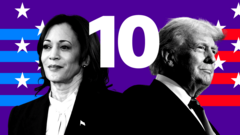The upcoming presidential election presents a unique deadlock between Kamala Harris and Donald Trump, with each candidate poised to secure critical voter support. Analyzing key factors that may influence the election outcome highlights their strategic advantages and the shifts in public sentiment that could tip the scales.
A Closer Look at the Race for the White House: Harris vs. Trump

A Closer Look at the Race for the White House: Harris vs. Trump
With just one day left until the pivotal election, both candidates, Kamala Harris and Donald Trump, have compelling reasons to remain optimistic about their prospects for victory.
As the presidential election nears its climax, the race between incumbent Vice President Kamala Harris and former President Donald Trump remains exceedingly tight. With national polls showcasing a neck-and-neck battle, both candidates can draw upon several factors that might give them a strategic edge.
Trump’s supporters could argue his chances based on the broader historical context and current issues affecting voters. For one, he’s not occupying the White House, meaning he can capitalize on public dissatisfaction with the existing administration. Economic concerns are at the forefront, as many Americans express apprehension about rising costs of living, despite the present low unemployment rates and a strong stock market. Trump can effectively channel voter sentiment by posing the pivotal question: “Are you better off than four years ago?” with a direct reference to inflation's impact on daily life.
Moreover, Trump's ability to withstand controversy and retain stable support is noteworthy. Even following his controversial term and various legal issues, his base has remained resolute, indicating a solid core of Republican support. His messaging around immigration resonates with many voters who have witnessed surging encounters at the U.S. border, positioning him as a trusted figure on this pressing issue.
In addition, Trump represents a demographic shift where non-college-educated voters, previously aligned with Democratic ideals, may find a new home within the Republican party, given his policies favoring American industry. His self-perception as a strong leader amidst global uncertainties can also appeal to voters yearning for decisiveness in turbulent times.
On the other hand, Harris’s campaign strategy hinges on drawing a stark contrast with Trump. Citing her vision for a stable and democratic governance, she positions herself as the antidote to the political chaos often associated with Trump’s leadership style. The specter of Trump’s past reign may galvanize voter turnout, particularly among moderate Republicans and independents who fear a repeat of that era.
Furthermore, Harris has effectively distanced herself from President Biden, allowing her a fresh platform for addressing critical issues such as women’s reproductive rights. The extremely consequential Supreme Court ruling that overturned Roe v. Wade has reignited voters' passions, and her advocacy on this front can drive substantial turnout among key demographics.
With voter demographics in mind, Harris also targets those most likely to show up at the polls—such as educated and older voters—contrasting Trump’s gains among younger, lower-turnout groups. Finally, her significant fundraising and strategic spending overt advantages could see her saturate swing states with impactful political advertising, a crucial factor as voters have their final say.
As the polls tighten, the stakes are undeniably high for both Harris and Trump, igniting a fierce competition that will undoubtedly shape the future of American politics.





















